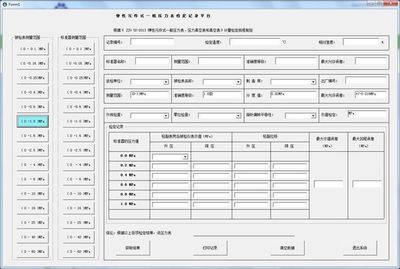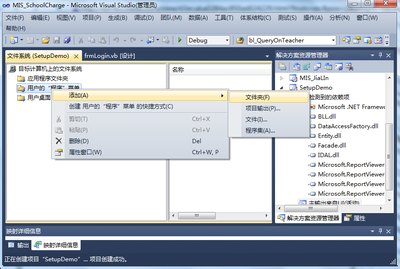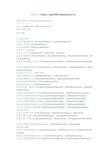如何有效的使用对话框之二
译者:徐景周(原作:NishantS ) 本文是《如何有效使用对话框》一文的继续. 1. 如何有效地使初始窗口不显示
当我们想让窗口初始时不显示时,通常会用ShowWindow(SW_HIDE),但实际上还是在启动是可以看到窗口一闪而过的痕迹。所以,可以使用下面的方法来实现它:
(1.1)先在构造函数中设置布乐变量 visible值为false. visible = false; (1.2)重载 WM_WINDOWPOSCHANGING,并添加下面代码:void CTest_deleteDlg::OnWindowPosChanging(WINDOWPOS FAR* lpwndpos) { if(!visible) lpwndpos->flags &= ~SWP_SHOWWINDOW; CDialog::OnWindowPosChanging(lpwndpos);}(1.3)然后设布尔visible变量值为true,并在要显示窗口时,再用ShowWindow(SW_SHOW)既可。visible = true;ShowWindow(SW_SHOW); 2. 对话框的全屏显示
对话框的全屏显示可以在OnInitDialog()中用 SetWindowPos 和HWND_TOPMOST 来实现对话框的重新大小。BOOL CFullScrDlgDlg::OnInitDialog(){ CDialog::OnInitDialog(); //... int cx, cy; HDC dc = ::GetDC(NULL); cx = GetDeviceCaps(dc,HORZRES) + GetSystemMetrics(SM_CXBORDER); cy = GetDeviceCaps(dc,VERTRES) + GetSystemMetrics(SM_CYBORDER); ::ReleaseDC(0,dc); //去除标题和边框 SetWindowLong(m_hWnd, GWL_STYLE, GetWindowLong(m_hWnd, GWL_STYLE) & (~(WS_CAPTION | WS_BORDER))); // 置对话框为最顶端并扩充到整个屏幕 ::SetWindowPos(m_hWnd, HWND_TOPMOST, -(GetSystemMetrics(SM_CXBORDER)+1), -(GetSystemMetrics(SM_CYBORDER)+1), cx+1,cy+1, SWP_NOZORDER); //... return TRUE; } 3. 如何在2K/xp下使窗口获取焦点
在2K/XP下我们可以用 AttachThreadInput和SetForegroundWindow来有效的获取焦点。//捕捉并设置当前焦点窗口为我们的窗口AttachThreadInput( GetWindowThreadProcessId( ::GetForegroundWindow(),NULL), GetCurrentThreadId(),TRUE);//置我们的为焦点窗口SetForegroundWindow();SetFocus(); //释放threadAttachThreadInput( GetWindowThreadProcessId( ::GetForegroundWindow(),NULL), GetCurrentThreadId(),FALSE); 4. 使你的对话框位于最顶端
可以直接在 OnInitDialog()中用SetWindowPos来实现。SetWindowPos(&this->wndTopMost,0,0,0,0,SWP_NOMOVE|SWP_NOSIZE); 5. 如何动态放大/缩小对话框
还是可以用SetWindowPos或MoveWindow来实现它。void CTest_deleteDlg::OnMakeSmall() { SetWindowPos(NULL,0,0,200,200,SWP_NOZORDER|SWP_NOMOVE); }void CTest_deleteDlg::OnExpand() { SetWindowPos(NULL,0,0,500,300,SWP_NOZORDER|SWP_NOMOVE); }或://伸、缩在IDC_DYCREDITS和IDC_COPYRIGHT两STATIC控件间,做为分隔线BOOL CAbout::OnInitDialog() { CDialog::OnInitDialog();//"关于"对话框中对话框可收缩效果 CRect Rect1,Rect2; //对话框收缩时大小 GetDlgItem(IDC_DYCREDITS)->GetWindowRect(Rect1); GetDlgItem(IDC_COPYRIGHT)->GetWindowRect(Rect2); m_nReducedHeight = Rect1.Height()+(Rect1.top -Rect2.bottom)/2; //收缩后窗体高度 dlgRect.bottom -= (Rect1.Height()+(Rect1.top -Rect2.bottom)/2); MoveWindow(&dlgRect); //如果要显示对话框起始动态效果的话,不能使用该句 m_bVertical=false; //默认收缩对话框}// ---------------------------------------------------------// 名称: OnMore// 功能: 是否允许显示// 变量: 无// 返回: 无// 编写: 徐景周,2002.4.8// ---------------------------------------------------------void CAbout::OnMore() { m_bVertical = !m_bVertical; if(m_bVertical == FALSE) //不显示 { SetDlgItemText(ID_MORE,_T("更多>>")); SizeWindow(m_nReducedHeight,true);// m_DyCredits.EndScrolling(); //停止滚动 } else //显示 { SetDlgItemText(ID_MORE,_T("<<隐藏")); SizeWindow(m_nReducedHeight,false); m_DyCredits.StartScrolling(); //开始滚动 } UpdateWindow(); }// ---------------------------------------------------------// 名称: SizeWindow// 功能: 伸展或收缩对话框 // 变量: ReduceHeight-收缩高度,bExtend-是否伸展// 返回: 无// 编写: 徐景周,2002.4.8// --------------------------------------------------------- void CAbout::SizeWindow(int ReduceHeight, bool bExtend){ CRect rc; GetWindowRect(&rc); if(bExtend) { for (int i= 0; i < ReduceHeight; i++) { rc.bottom--; MoveWindow(&rc); } } else { for (int i= 0; i < ReduceHeight; i++) { rc.bottom++; MoveWindow(&rc); } }} 6. 如何让对话框回到屏幕中来
当对话框被拖离屏幕时,可用下面代码使其回到屏幕中。SendMessage(DM_REPOSITION); 注:它必须是顶端窗口且不是child窗口。
7. 如何给对话框添加或去掉最大/最小化按钮
在OnCreate()或OnInitDialog() 改变其显示风格既可。int CTest_deleteDlg::OnCreate(LPCREATESTRUCT lpCreateStruct) { if (CDialog::OnCreate(lpCreateStruct) == -1) return -1; // TODO: Add your specialized creation code here SetWindowLong(this->m_hWnd,GWL_STYLE, GetWindowLong(this->m_hWnd,GWL_STYLE) | WS_MINIMIZEBOX | WS_MAXIMIZEBOX); return 0;}或用:ModifyStyle (NULL, WS_MAXIMIZEBOX); 8. 改变鼠标指针
可以在OnSetCursor中实现.BOOL CTest_deleteDlg::OnSetCursor(CWnd* pWnd, UINT nHitTest, UINT message) { // TODO: Add your message handler code here and/or call default SetCursor(AfxGetApp()->LoadStandardCursor(IDC_UPARROW)); // Now we return instead of calling the base class return 0; // return CDialog::OnSetCursor(pWnd, nHitTest, message);} 9. 改变对话框的前景和背景色
可以在InitInstance()中实现。//红色背景、绿色前景SetDialogBkColor(RGB(255,0,0),RGB(0,255,0)); 10. 在任务条上不显示图标
先从CWinApp继承类中建立一个不显示的顶级窗口.CFrameWnd *abc=new CFrameWnd();abc->Create(0,0,WS_OVERLAPPEDWINDOW);CNoTaskBarIconDlg dlg(abc);m_pMainWnd = &dlg;int nResponse = dlg.DoModal();if (nResponse == IDOK){}else if (nResponse == IDCANCEL){}delete abc;在 OnInitDialog中修改显示风格 WS_EX_APPWINDOW.BOOL CNoTaskBarIconDlg::OnInitDialog(){ CDialog::OnInitDialog(); ModifyStyleEx(WS_EX_APPWINDOW,0); SetIcon(m_hIcon, TRUE); // Set big icon SetIcon(m_hIcon, FALSE); // Set small icon // TODO: Add extra initialization here return TRUE; // return TRUE unless you set the focus to a control} 11. 加入上、下文帮助
在 OnInitDialog 修改显示风格,加入上、下文HLP帮助显示.BOOL HelpDialog::OnInitDialog() { ModifyStyleEx(0, WS_EX_CONTEXTHELP); return CDialog::OnInitDialog();}重载OnHelpInfo(...),用显示相关帮助信息BOOL HelpDialog::OnHelpInfo(HELPINFO* pHelpInfo) { short state = GetKeyState (VK_F1); if (state < 0) // F1 key is down, get help for the dialog return CDialog::OnHelpInfo(pHelpInfo); else { // F1 key not down, get help for specific control if (pHelpInfo->dwContextId) WinHelp (pHelpInfo->dwContextId, HELP_CONTEXTPOPUP); return TRUE; }}译者联系方式:
作者EMAIL:jingzhou_xu@163.net
未来工作室(Future Studio)

|



